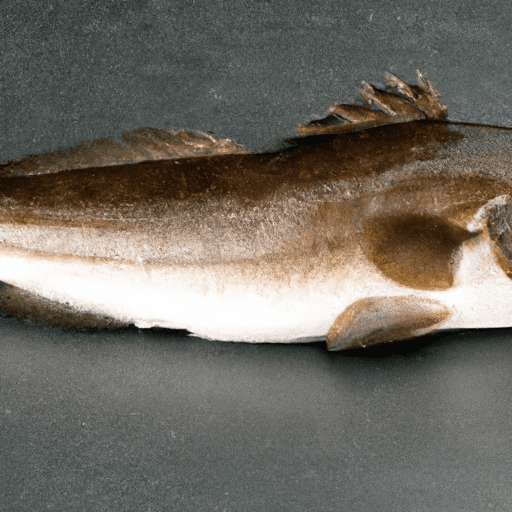Discover the Delightful and Versatile Black Cod
When it comes to indulging our taste buds, black cod is a true superstar. Renowned for its buttery texture, rich flavor, and endless culinary possibilities, this delectable fish has captivated food lovers around the world. In this blog post, we will dive into the fascinating world of black cod, exploring its taste, culinary uses, nutritional value, and some intriguing historical facts. So, let’s embark on this flavorsome journey together!
What is Black Cod?
Black cod, also known as sablefish, is a species native to the North Pacific Ocean. Despite its name, black cod is not a true cod but belongs to the family Anoplopomatidae. It possesses a distinctive elongated body with a dark black and greenish skin, which sets it apart from other fish varieties. Renowned for its high oil content, this fish exhibits a delicate and succulent flesh that practically melts in your mouth.
Taste and Culinary Uses
One of the standout characteristics of black cod is its buttery and velvety texture, which provides an unparalleled dining experience. Its flavor is often described as rich, succulent, and mildly sweet, making it an absolute delight for seafood enthusiasts.
Due to its exceptional taste and texture, black cod is a sought-after ingredient in various cuisines worldwide. In Japanese cuisine, it is famously known as “Gindara” and is highly prized for its use in sushi and sashimi. Its luscious flesh withstands different cooking methods, such as grilling, broiling, baking, or even smoking, without losing its delicate texture and flavor.
Furthermore, black cod’s versatility shines through as it easily absorbs different flavors when marinated or glazed. Its high oil content allows it to hold up well to robust seasonings, making it a perfect canvas for creative culinary experiments. Whether you prefer a miso glaze, soy-based marinade, or a citrusy twist, black cod is guaranteed to elevate your dish to new heights.
Nutritional Value
Apart from its exceptional taste, black cod boasts an impressive nutritional profile. Rich in omega-3 fatty acids, it supports heart and brain health, reduces inflammation, and offers various other health benefits. Additionally, black cod is an excellent source of quality proteins, vitamins, and minerals, including vitamin D, vitamin B12, selenium, and phosphorus.
Its low mercury levels compared to other fish varieties make black cod a safe seafood choice, ensuring that you can relish its delectable flavor with peace of mind.
Historical Significance and Facts
Black cod has a rich history intertwined with the coastal communities of North America and Asia. Native Americans of the Pacific Northwest have long revered black cod for its abundance and sustenance. It also holds cultural importance as a traditional food among indigenous tribes.
Interestingly, black cod played a vital role in deepening diplomatic ties between the United States and Japan. Following World War II, black cod (then known as “sablefish”) became a staple ingredient in Japan during the post-war reconstruction period. This preference sparked a flourishing trade between the two nations, fostering a lasting culinary bond.
The Time Has Come to Savor Black Cod
Black cod’s unmatched flavor, velvety texture, and versatility have solidified its reputation as an esteemed seafood delicacy. Whether you are an adventurous home cook or a seasoned chef, black cod offers endless opportunities to create memorable culinary delights. Its buttery taste and nutritional benefits make it a win-win for both your taste buds and your health.
So why not embark on a flavorsome journey and explore the wonders of black cod? With its exceptional attributes and culinary possibilities, this incredible fish is sure to impress and satisfy even the most discerning palates.
Black cod is a species of fish known scientifically as Anoplopoma fimbria. Here are some interesting facts about black cod:
Origin:
- Black cod is native to the North Pacific Ocean, particularly the waters of North America and Japan.
- It is found in the Pacific Ocean, from central California in the United States to the Bering Sea and Japan.
- The biggest populations are found in Alaska and British Columbia.
Common Uses:
- Black cod is highly valued for its delicate flavor, buttery texture, and high oil content.
- It is commonly used in Asian cuisines, particularly in Japanese and Korean dishes.
- Popular preparations include grilling, broiling, baking, or even curing and smoking.
- It is often marinated or glazed with ingredients like miso, soy sauce, or mirin to enhance its flavor.
Nutritional Benefits:
- Black cod is a good source of lean protein, with approximately 22 grams of protein per 100 grams.
- It is rich in omega-3 fatty acids, which contribute to heart health and have anti-inflammatory benefits.
- This fish is also a good source of essential nutrients like vitamin D, vitamin B12, and selenium.
- It has a relatively low calorie content, with approximately 150 calories per 100 grams.
Unique Properties and Historical Significance:
- Black cod has a unique fat content that gives it a silky, buttery texture even when cooked.
- Its flesh is white when raw but turns opaque and flaky when cooked.
- Black cod has been traditionally prized by Indigenous peoples of the Pacific Northwest, who have relied on it as a food source for centuries.
- The fish played a significant role in the history of the Alaska commercial fishing industry, particularly during the 20th century.
These facts highlight the origin, common uses, nutritional benefits, and unique properties of black cod.




Use the share button below if you liked it.
It makes me smile, when I see it.